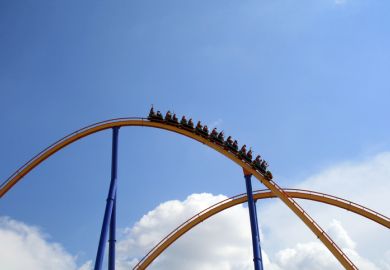Christmas this year falls on April 25, for on that day Eric Drexler, prophet of nanotechnology, was born. Then we enter ad 40, anno Drexler, or as some would prefer, nano Drexler. Our prophet, according to this uncritical hagiography, sees a handsome future in which nothing material is impossible literally nothing. Every one of us will have the ultimate in the Welfare State autoclave in our kitchen, in which the ultimate slaves, the "assemblers", will effect our merest whim for a couple of pence (which we could forge anyway). From our holographic catalogue (itself constructed on initial boot-up and maintained current by the satellite down-link we constructed in the first tutorial) we can select a fine filet mignon encrusted with rubies, or a new carburettor, or perhaps just a gin and tonic or an RB211 engine. All we have to do, is to feed the autoclave with yesterday's tired old toys, faeces, rubber tyres, and wait ten minutes (presumably a minute or two longer for the RB211) and hey presto! serve it up, piping hot.
This is Ed Regis's interpretation of Drexler's vision of the world perhaps as little as 15 years from now. Provided, that is, chemists and physicists can keep up with the demands of imagination. By ad 55 (2010 old style), our diseases will be doctored by nanosurgeons hacking off platelets, skewering viruses, and strong-arming recalcitrantly uncoiling DNA into submission. We shall, by ad 55 or shortly thereafter (depending on the cussedness of matter, of course, and the weak-mindedness of government agencies willing to pour billions into these imaginative plans) be on the brink of living on a perpetually satisfied whim. A wish for that . . . granted! A wish for this . . . likewise! Allwe have to do is to make those cussed little assemblers.
Assemblers are really quite easy to make (we are told). All we have to do is to synthesize a polypeptide chain that folds up into a machine, or a component of a machine lathe, dredger, what you will. That is really quite easy, because everyone knows that we have cracked the genetic code of DNA and can already fabricate proteins (of a kind).
Oh yes, in support of the temporal proximity of this achievement Regis cites the molecular railway with little trains whizzing from station to station (agreed, made by an entirely different procedure, but that is only an irksome detail, and should not stand in the way of the vision) and the atomic force microscope (agreed, functioning on entirely different principles, but it is the idea that matters). So, with all this abundant evidence, we can be pretty sure that assemblers are just around the corner.
Regis's version of Drexler's vision is highly reminiscent of the writings of Daedalus, once of the New Scientist and now of Nature. Daedalus's amusing forte is to take a scientific principle or achievement and to extrapolate it hugely, maybe exaggerating a law (but not all laws), or exaggerating what has already been achieved in a chemical synthesis and saying "only if. . .". Daedalus is manifest fun. Regis's proselytising on behalf of Drexler's musing is deadly serious (I looked for the tongue, but am confident it is not in the cheek). Drexler (an all pervasive presence on these pages) and Regis (effectively acting as his publicity agent, a kind of macro assembler for Drexler's image, if one were needed) really believe in the future Drexler foresees and Regis elaborates.
And how easy it is to overcome the problems that might arise! An axle of carbynes fine, we'll have some. Come on chemists, cut down their reactivity so that this nanomachine will work and cure mankind of all known diseases and the recreational diseases that we will be able to invent. Hmmm. . . a bit wobbly that nanostructure. Simple: strengthen those darn bonds! Come on chemists and molecular biologists, just find a peptide sequence that will coil up into the re-entrant phototablature fretsaw with automatic holographic feedback: we can promise you all possible amino acids, not the paltry 20 or so that nature deploys, and you can have DNA in any sequence.
There is, I have to admit, a difficulty with reviewing a book like this. To say it is science fiction (which it is) opens one up to a justifiable charge of small-mindedness. Indeed, there are other dangers in forwarding such a charge, for science fiction does often (but by no means always) come true. Then, to concur that this is indeed a vision of the future opens one up to the charge of gullibility.
I suspect that certain aspects of the Regis-propagated version of Drexler's vision will come about, for nanotechnology is the next step along from microtechnology and an analogue of molecular biology, but I would be greatly surprised if it came about in the manner described here. The future, on any scale, will make much more subtle use of new materials than imagined here, and it will not be able to deploy the cavalier chemistry that the whimsical speculations require. I think we do not yet need to start worrying about terrorist attacks by armies of assemblers, or assemblers gone feral, disassembling us to grey goo.
Peter Atkins is lecturer in physical chemistry, University of Oxford.
Nano!: Remaking the World Atom
Author - Ed Regis
ISBN - 0593 0868
Publisher - Bantam
Price - £16.99
Pages - 307
Register to continue
Why register?
- Registration is free and only takes a moment
- Once registered, you can read 3 articles a month
- Sign up for our newsletter
Subscribe
Or subscribe for unlimited access to:
- Unlimited access to news, views, insights & reviews
- Digital editions
- Digital access to THE’s university and college rankings analysis
Already registered or a current subscriber? Login


